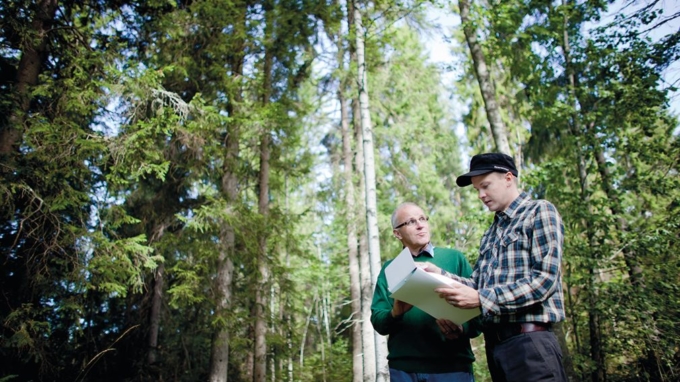In forest sales the contract parties are the buyer and seller. The responsibilities and rights vary, depending on the type of contract.
The forest owner can also use a representative, a person from the forestry association or authorize someone else to act on his behalf.
Forestry associations are often authorized to conduct business on behalf of the seller: the representative negotiates and agrees prices and other terms, often dealing with several potential buyers at the time in order to maximise the seller’s revenue. This type of selling is very commonplace today.

© Stora Enso/Henrik Kettunen
The current sales and purchasing practices are a result of a long pattern.
The most important attachment to the contract revolves around each wood product type’s measuring and quality requirements. These tend to change mainly according to the felling season.
General
During the sale and the marking of the trees both parties agree about the logging area, volumes, prices and also the quality and length requirements, felling practices and forest handling, logging time, collection of energy wood and the storage of timber.
As subcontractors and third-party operators are often used during the sale and felling it is imperative that the tasks, rights and responsibilities are well defined.
There is not any specific legislation governing wood procurement, but everything happens within the general Finnish legal framework covering contracts, ownership and taxation.
There are, however, a few forest linked laws, which set rules for the wood trading, felling and the measuring of wood. Most important ones of these are forestry law, the law for the use of land and construction, and common forest law.
Furthermore, the wood trading follows the rules set by the Natural Resource Institute of Finland.
Different types of trading
Standing sale and delivered to the roadside are the most common ways of trading.
Standing sale
- The seller contractually gives the buyer the right to fell and transport the sold wood from the forest within an agreed time limit.
- The standing sale defines clearly the area designated for the logging, or alternatively an agreed volume of a certain type of wood.
- Each type from above is priced separately. With pricing there are usually different price groups, in which the cubic-meter prices vary – depending for instance, how the felling is done.
- With pricing, one also takes into account factors like whether the forest lot is accessible only in winter, all year round or whether there are restrictions as regards weight on forest road transportation during the thawing period in springtime. Terrain and the ease of felling is also another factor.
Delivered to the roadside contract
- The seller agrees to deliver an agreed volume of contacted type of wood, within agreed quality and length parameters.
- The felling area is also determined in the contract.
- The roadside storage places have to be along a route that is suitable and accessible for the trucks taking care of the long-distance haulage.
- Delivery-based contracts are normally fixed before the felling starts.
Joint sales
Joint sales by several forest owners follows similar procedures with the roadside contract.
Usually the forestry association pools together the sellers, arranges a joint sale as well as the felling. From the sellers point of view this type of a contract is similar to a standing sale, but for the buyer it is akin to the roadside delivery contract.
What does the marking of the trees mean?
The marking of trees means the choosing of the trees for felling.
Method:
- The marking is done by determining the logging area and the type of logging method there.
- The logging methods are stipulated by the regional forest tending regulations of the forestry associations or other organisations.
- The final choice of which trees are cut is, however, usually left with the harvester operator or lumberjack. In this case individual trees are not marked.
- Obviously, there are also cases for the opposite in areas, where environmental and visual factors are particularly important or seeding trees or fringe areas of the felling area have to be clearly defined.
The marking can be made by the forest owner, forestry association or a forestry service representative.
Energy wood
When a felling contract is fixed the parties can also agree on the sale, procurement and transportation of energy wood, which covers the residual wood material.
In practice energy wood consists of branches, tree tops, forest removal of other unsuitable material and the stumps. This type of material is not usually collected from the smaller thinnings, where the average tree size and volumes tend to be small.
The number of energy wood only contracts is on an increase – then only energy wood is removed from younger forests in similar fashion like with the normal fellings.
Energy wood can also be sold by the forest owner delivered to the roadside, terminal or the enduse location.
In case of energy wood, there are not any contract forms or practices, nor measuring guidelines and prices. Usually, the pricing is linked to the felling area or the expected volume of primary wood products of the contract.
Price can also be determined by volume, weight or energy content. Energy wood procurement details are agreed between the buyer and seller in the actual contract.
Restrictions of forest use
Before the sales contract is closed the parties have to check possible restrictions for the logging area:
- Finnish forestry law determines the general principles for the use of forests and nature preservation.
- In zoned areas fellings and other forestry related actions may be restricted with special stipulations.
- A specific notification of forest use is a must in these cases.
- In zoned areas, if specified, one would also need landscaping permission.

